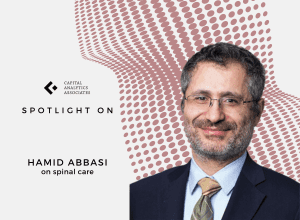Spotlight On: Hamid Abbasi, Chief Technology Officer, Inspired Spine
 September 2024 — Invest: spoke with Hamid Abbasi, chief technology officer of Inspired Spine, to discuss the latest advancements in minimally invasive spinal surgery, exploring significant milestones, innovative techniques, and the future of spinal care.
September 2024 — Invest: spoke with Hamid Abbasi, chief technology officer of Inspired Spine, to discuss the latest advancements in minimally invasive spinal surgery, exploring significant milestones, innovative techniques, and the future of spinal care.
What were the significant milestones and achievements for Inspired Spine over the last 12 to 18 months?
One of the most important milestones we’ve achieved at Inspired Spine is our ability to perform complex surgeries, typically done in hospitals and in a surgical center setting. These surgeries were once so invasive that they required hospitalization with ICU stays and significant high-level medical care. Now, we can perform them in our surgical center because the level of tissue damage is minimal, allowing patients to be discharged within hours rather than after a week. This is a tremendous achievement by any standard. Nationally, less than 2% of lumbar spinal fusions are performed in surgery centers, but we manage to perform 75% of our spinal fusions in this setting. This is crucial because shifting procedures from hospitals to surgery centers not only benefits patients by lowering risks and increasing their return to daily activities but also significantly reduces healthcare costs.
How has Inspired Spine advanced minimally invasive spinal surgery techniques over the past few years?
We’ve been performing spinal fusions for the last 70 years, yet about 80% of lumbar spinal fusions are still performed using the Transforaminal Lumbar Interbody Fusion technique, which is about 35 years old. The field needs an update, and we are combining modern technology and anatomy to pioneer new surgical methods. For instance, what was once a major surgery causing significant damage to surrounding tissues can now be performed through an incision less than half an inch with tools smaller than a pen. This allows us to achieve the same results with minimal impact on surrounding tissues. Of course, this requires advanced technology and extensive training, which is why we’ve not only developed the technology but also a training curriculum to support these procedures.
[fusion_images order_by=”desc” picture_size=”auto” hover_type=”none” autoplay=”yes” autoplay_speed=”3000″ flex_align_items=”center” columns=”1″ column_spacing=”0″ scroll_items=”” show_nav=”yes” mouse_scroll=”no” border=”no” lightbox=”no” margin_top=”” margin_right=”” margin_bottom=”” margin_left=”” hide_on_mobile=”small-visibility,medium-visibility,large-visibility” class=”” id=”” caption_style=”off” caption_title_tag=”2″ fusion_font_family_caption_title_font=”” fusion_font_variant_caption_title_font=”” caption_title_size=”” caption_title_line_height=”” caption_title_letter_spacing=”” caption_title_transform=”” caption_title_color=”” hue=”” saturation=”” lightness=”” alpha=”” caption_background_color=”” fusion_font_family_caption_text_font=”” fusion_font_variant_caption_text_font=”” caption_text_size=”” caption_text_line_height=”” caption_text_letter_spacing=”” caption_text_transform=”” caption_text_color=”” caption_border_color=”” caption_overlay_color=”” caption_align_medium=”none” caption_align_small=”none” caption_align=”none” caption_margin_top=”” caption_margin_right=”” caption_margin_bottom=”” caption_margin_left=”” parent_dynamic_content=””] [fusion_image image=”https://capitalanalyticsassociates.com/wp-content/uploads/2024/07/CAA24_Invest-Insights-S6-Web-Banners-7.jpg” image_id=”64377″ image_title=”” image_caption=”” link=”” linktarget=”_self” alt=”” /] [fusion_image image=”https://capitalanalyticsassociates.com/wp-content/uploads/2024/07/CAA24_Invest-Insights-S6-Web-Banners-10.jpg” image_id=”64380″ image_title=”” image_caption=”” link=”” linktarget=”_self” alt=”” /] [fusion_image image=”https://capitalanalyticsassociates.com/wp-content/uploads/2024/07/CAA24_Invest-Insights-S6-Web-Banners-9.jpg” image_id=”64379″ image_title=”” image_caption=”” link=”” linktarget=”_self” alt=”” /] [fusion_image image=”https://capitalanalyticsassociates.com/wp-content/uploads/2024/07/CAA24_Invest-Insights-S6-Web-Banners-8.jpg” image_id=”64378″ image_title=”” image_caption=”” link=”” linktarget=”_self” alt=”” /] [/fusion_images]
How has Inspired Spine’s visual training program for surgeons influenced the adoption of your procedures in other medical centers and even internationally?
It’s important to understand that new technology brings its own challenges, especially with complex procedures like ours. Traditionally, these surgeries can take five to six hours, but we complete them in under an hour and send patients home within two hours. This requires highly sophisticated technology and a solid training program. We’ve developed a curriculum called “Soft Transitions,” modeled after flight school training. In aviation, which is inherently complex, we’ve learned how to best train pilots over the last 100 years. We’ve borrowed many of those principles for our training, ensuring proper steps are followed to maximize learning while minimizing risks. Our program pairs experienced surgeons with less experienced ones, gradually increasing the complexity of the tasks until they reach full competence.
How is Inspired Spine contributing to the broader industry discussions about the future of spinal surgery?
Spinal surgery is a conservative field, and for good reason. Patient safety is our top priority, and any new technology must undergo rigorous evaluation. We’ve created a consortium of medical professionals and industry partners who are committed to advancing these minimally invasive techniques. It’s said that it can take 20-30 years for new medical technology to become widely adopted. Given that over 1.5 million spinal fusions are performed annually in the United States, transitioning to minimally invasive methods can significantly reduce patient risks. The mortality rate for traditional spinal surgery is about 0.3%, which equates to the equivalent of 20-25 passenger airplane crashes annually in terms of lives lost. Our minimally invasive procedure has had a mortality rate of zero, demonstrating its potential to save lives and expand the range of patients eligible for surgery. We can’t afford to wait decades for this technology to become the norm; our consortium accelerates its adoption and implementation.
Given the high number of spinal fusions performed each year, how is Inspired Spine adapting to meet demand?
While it’s impossible for us alone to handle 1.5 million surgeries, we are creating a domino effect by training surgeons and expanding our network. These trained surgeons are then encouraged to train others, creating a ripple effect. By developing a structured curriculum and leveraging technology, we aim to capture the attention of the medical community worldwide. One of our successful outreach initiatives is the Kambin Society, which we launched three months ago and already has over 1,000 members. This platform helps us spread the word nationally and internationally.
What advice would you give to young surgeons entering the field and interested in specializing in minimally invasive spine surgery?
My advice is simple: immerse yourself in minimally invasive techniques. If young surgeons don’t adapt to these methods, their training from residency will be outdated within three to five years. The differences between traditional and minimally invasive surgeries are significant, both in patient outcomes and in professional advancement. Today, patients are well-informed and research their treatment options online. Surgeons who don’t adopt minimally invasive approaches may struggle professionally as patient demand for these advanced techniques continues to grow.
What can individuals do to prevent the need for spinal surgery?
There are steps you can take. We have a podcast series called “Essence of Medicine,” which includes an episode on the natural history of the spine. I liken the spine to a car tire; just as a tire provides cushioning between a car and the road, spinal discs cushion the bones in your back. Aging, genetics, and lifestyle all impact spinal health. While we can’t control our genetics or the natural aging process, we can choose lifestyles that minimize damage. Moderation is key — neither a sedentary lifestyle nor excessive physical activity is beneficial. This podcast episode delves into the best practices for maintaining a healthy spine, and I encourage you to check it out.
What are your top priorities and goals for Inspired Spine over the next few years, and what strategies will you use to achieve them?
Like any disruptive technology, we face resistance from established interests. Our main goal over the next few years is to educate patients and raise awareness from the ground up. We have over 1,000 patient testimonials that help inform people about their surgical options and what to consider. By focusing on patient education, we can create demand for minimally invasive techniques and ultimately improve patient outcomes. We plan to launch significant public awareness initiatives in the coming years to inform people about how they can protect their spine health and make informed decisions about surgical care.
If you’re human, you have a spine, and if you have a spine, you will likely encounter spine problems at some point. By age 50, about 75% of people experience spine issues; by age 60, it’s 95%, and by age 70, it’s 98%. These problems are common, so it’s essential to be proactive. Research and understand your options, including the benefits and risks of different types of surgeries. Ask your surgeon about minimally invasive options and their success rates. It’s always wise to stay informed, especially about something as crucial as your spine.
For more information, please visit:













